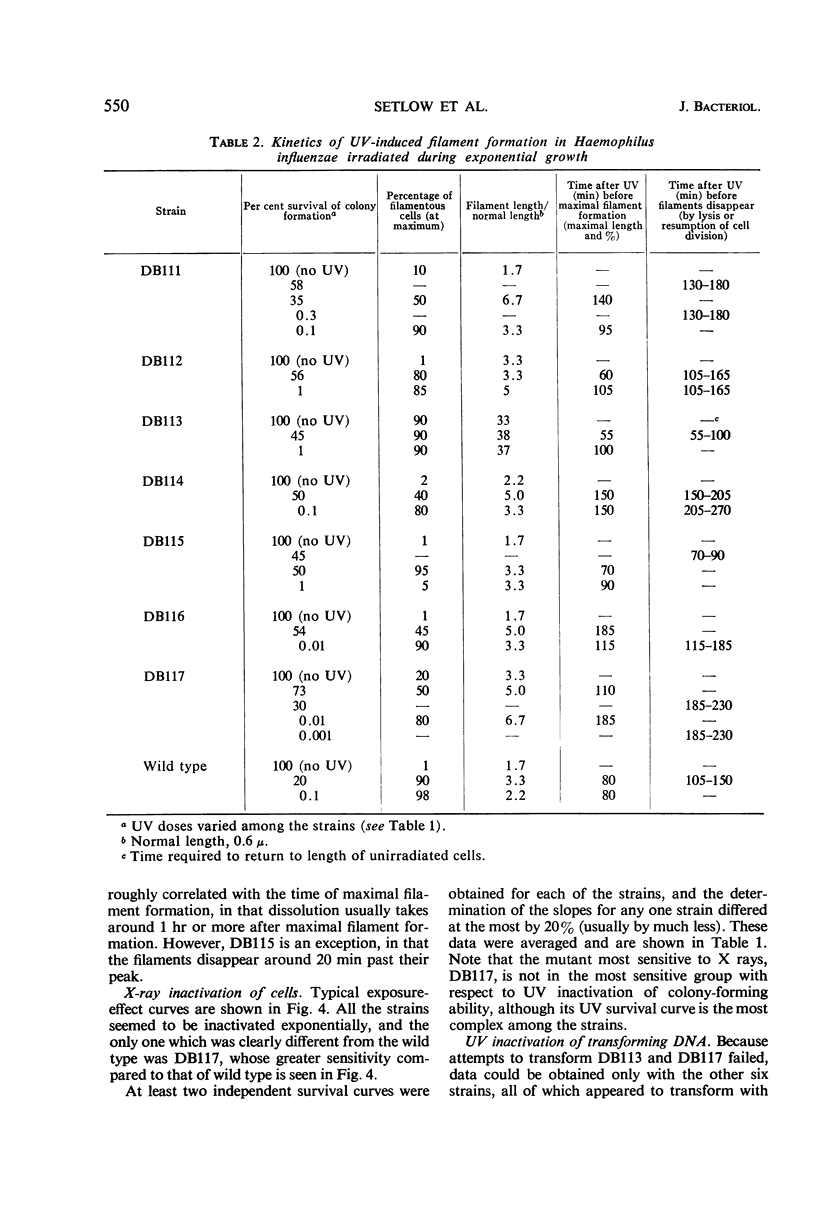Abstract
Seven mutants of Haemophilus influenzae were isolated by the criterion of sensitivity to ultraviolet (UV) inactivation of colony formation. These mutants and the wild type were characterized with regard to X-ray inactivation of colony formation, UV induction of division inhibition, the ability of the eight strains to act as recipients to UV-irradiated H. influenzae phage and transforming deoxyribonucleic acid (DNA), and the influence of acriflavine on the survival of UV-irradiated transforming DNA with these strains as recipients. The photoreactivable sector of transforming DNA with yeast photoreactivating enzyme was measured for the most UV-sensitive mutant and was found to be greater than that of wild type. Judged by the above criteria, the order of the strains' sensitivities shows some, but by no means complete, correlation from one type of sensitivity characterization to another, indicating that a minimum of two variables is needed to explain the differences in the strains. Acriflavine increases the UV sensitivity of transforming DNA except in the most sensitive mutant. This effect is usually, but not always, more pronounced in the case of the more UV-resistant marker. The acriflavine effect is postulated to be the result of at least two factors: (i) interference with repair of transforming DNA in the host cell, and (ii) interference with the probability of recombination between transforming DNA and host DNA.
Full text
PDF












Images in this article
Selected References
These references are in PubMed. This may not be the complete list of references from this article.
- DOERMANN A. H. The analysis of ultraviolet lesions in bacteriophage T4 by cross reactivation. J Cell Comp Physiol. 1961 Dec;58(3):79–93. doi: 10.1002/jcp.1030580409. [DOI] [PubMed] [Google Scholar]
- GOODGAL S. H., HERRIOTT R. M. Studies on transformations of Hemophilus influenzae. I. Competence. J Gen Physiol. 1961 Jul;44:1201–1227. doi: 10.1085/jgp.44.6.1201. [DOI] [PMC free article] [PubMed] [Google Scholar]
- HARM W., RUPERT C. S. INFECTION OF TRANSFORMABLE CELLS OF HAEMOPHILUS INFLUENZAE BY BACTERIOPHAGE AND BACTERIOPHAGE DNA. Z Vererbungsl. 1963 Dec 30;94:336–348. doi: 10.1007/BF00897593. [DOI] [PubMed] [Google Scholar]
- Louarn J. M., Sicard A. M. Sur la sensibilité différentielle des marqueurs génétiques aux rayonnements ultraviolets, et les mécanismes de réactivation au cours de la transformation chez Diplococcus pneumoniae. C R Acad Sci Hebd Seances Acad Sci D. 1965 Jul 19;261(3):852–855. [PubMed] [Google Scholar]
- Mahler I. Characteristics of an ultraviolet irradiation sensitive strain of Bacillus subtilis. Biochem Biophys Res Commun. 1965 Nov 22;21(4):384–391. doi: 10.1016/0006-291x(65)90206-8. [DOI] [PubMed] [Google Scholar]
- Muhammed A. Studies on the yeast photoreactivating enzyme. I. A method for the large scale purification and some properties of the enzyme. J Biol Chem. 1966 Jan 25;241(2):516–523. [PubMed] [Google Scholar]
- Munakata N., Saito H., Ikeda Y. Inactivation of transforming DNA by ultraviolet irradiation. Mutat Res. 1966 Apr;3(2):93–100. doi: 10.1016/0027-5107(66)90022-4. [DOI] [PubMed] [Google Scholar]
- Notani N. K., Goodgal S. H. Decrease in integration of transforming DNA of Hemophilus influenzae following ultraviolet irradiation. J Mol Biol. 1965 Sep;13(2):611–613. doi: 10.1016/s0022-2836(65)80126-7. [DOI] [PubMed] [Google Scholar]
- Okubo S., Romig W. R. Comparison of ultraviolet sensitivity of Bacillus subtilis bacteriophage SPO2 and its infectious DNA. J Mol Biol. 1965 Nov;14(1):130–142. doi: 10.1016/s0022-2836(65)80235-2. [DOI] [PubMed] [Google Scholar]
- Patrick M. H., Rupert C. S. The effects of host-cell reactivation on assay of U.V.-irradiated Haemophilus influenzae transforming DNA. Photochem Photobiol. 1967 Jan;6(1):1–20. doi: 10.1111/j.1751-1097.1967.tb08785.x. [DOI] [PubMed] [Google Scholar]
- RAVIN A. W. The genetics of transformation. Adv Genet. 1961;10:61–163. doi: 10.1016/s0065-2660(08)60116-9. [DOI] [PubMed] [Google Scholar]
- SAUERBIER W. The influence of the metabolic state of the host bacteria on the survival of phage T1 irradiated with ultraviolet light. Virology. 1962 May;17:164–170. doi: 10.1016/0042-6822(62)90093-4. [DOI] [PubMed] [Google Scholar]
- SETLOW R. B., CARRIER W. L. THE DISAPPEARANCE OF THYMINE DIMERS FROM DNA: AN ERROR-CORRECTING MECHANISM. Proc Natl Acad Sci U S A. 1964 Feb;51:226–231. doi: 10.1073/pnas.51.2.226. [DOI] [PMC free article] [PubMed] [Google Scholar]
- SETLOW R. B. PHYSICAL CHANGES AND MUTAGENESIS. J Cell Physiol. 1964 Oct;64:SUPPL 1–1:68. [PubMed] [Google Scholar]
- SETLOW R. B., SETLOW J. K. Evidence that ultraviolet-induced thymine dimers in DNA cause biological damage. Proc Natl Acad Sci U S A. 1962 Jul 15;48:1250–1257. doi: 10.1073/pnas.48.7.1250. [DOI] [PMC free article] [PubMed] [Google Scholar]
- STUY J. H. Studies on the radiation inactivation of microorganisms. V. Deoxyribonucleic acid metabolism in ultraviolet-irradiated Haemophilus influenzae. J Bacteriol. 1959 Jul;78(1):49–58. doi: 10.1128/jb.78.1.49-58.1959. [DOI] [PMC free article] [PubMed] [Google Scholar]
- Setlow J. K., Boling M. E., Bollum F. J. The chemical nature of photoreactivable lesions in DNA. Proc Natl Acad Sci U S A. 1965 Jun;53(6):1430–1436. doi: 10.1073/pnas.53.6.1430. [DOI] [PMC free article] [PubMed] [Google Scholar]



